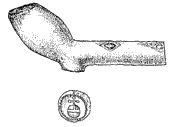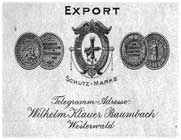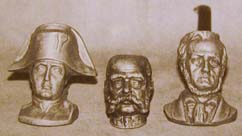No. 9/1997, p. 1-4
Martin Kügler: Report on the 10th meeting of the German
Society for Clay-Pipe Research
held in Hamburg-Harburg on 4 and 5 May 1996
The meeting was attended by 43 members and took place in the Helms
Museum in Hamburg-Harburg at the invitation of the Hamburg Museum
for Archaeology and the History of Harburg. The lectures given by
J. Claußnitzer, E. Först, and R. Articus dealt with the
archaeology of Hamburg and clay pipes found in the city of Hamburg
and its surroundings (Knasterkopf No. 9/1997, p. 4-44). M. Kügler
gave an account of the export of Westerwald clay pipes abroad (Knasterkopf
No. 9/1997, p. 45-58). T. Witkowska reported on the clay-pipe factories
in Rostin and Sborovsky, and H. Haettich gave a lecture on Marek
Parol, a Polish clay-pipe maker (Knasterkopf No. 9/1997, p. 58-68
and 68-72, respectively). N. Surabian provided the first account
of clay pipe making in St. Petersburg (Knasterkopf No. 9/1997, p.
73-85). An important discovery was described by G. Almeling: the
clay-pipe factory of Chr. Casselmann in Hannoversch Münden.
The excursion visited the Reemtsma History of Tobacco Collection
and the private collection belonging to Gerd Jansen.

|
|
|

Pipe with double-cone shaped bowl, showing the "orb"
heel mark and "fleur-de-lis" stem marks, Gouda, first
half of 17th century
|
No. 9/1997, p. 4-44
Rüdiger Articus: How clay pipes came to the Lüneburg
Heath area
It is shown from written sources that clay-pipe smoking was known
in Harburg shortly before 1600, and by 1630 had gained general acceptance
in country areas. On the basis of studies of a large number of clay-pipe
localities, it can be demonstrated that, since the end of the 17th
century, smokers in Hamburg and in the towns on the Lüneburg
Heath were adequately supplied with pipes imported from the Netherlands.
In contrast, in the small towns and in rural districts, most clay
pipes smoked came from German production sites in Lower Saxony and
northern Hessen. The author deals with some early Dutch pipes and
particulary with finds marked "SAPPFENBERG" from an unknown
German manufacture, as well as a number of other pipes marked with
the name of the pipe maker, e.g. Johann Hartmann Iser in Hildesheim,
Johann Henrich Christoph Bosse in Walbeck and Christian Casselmann
in Grossalmerode and 1772-1776 in Hannoversch Münden.

Pipe with heel, showing a rosette on both sides of
the bowl, Holland, end of 17th century

|
|
Working ina pipe factory, Baumbach, around 1910/1920
|
No. 9/1997, p. 45-58
Martin Kügler: The importance of Hamburg as a place of transshipment
for clay pipes from the Westerwald in the 18th and 19th century
On account of the very high Dutch import and transit duties introduced
around 1800, the flourishing trade enjoyed by the Westerwald pipe
makers during the 18th century almost came to a stop. However, as
late as 1850, a vigorous export trade with countries in northern Europe
and overseas commenced, which was conducted through export companies
in Hamburg. Shipping agents such as the Thomae brothers acted on behalf
of both the export companies and the pipe makers in the Westerwald.
These activities are documented in detail in letters and orders addressed
to the clay-pipe factory of Wilhelm Klauer in Baumbach between 1880
and 1887. The agents also fulfilled the function of a market observer
and gave the pipe maker useful tips on new pipe design.

zoom

|
|
|

zoom
|
No. 9/1997, p. 59-68
Teresa Witkowska: The Prussian clay-pipe factories at Rostin and
Sborovsky in present-day Poland. Report on archaeological research
In the early 1750s, pipe factories were etablished by merchants in Rostin
and Sborovsky. Apart from archive material, extensive finds were made
during the 1989-90 excavations, and in Sborovsky one of the four buildings
of the clay-pipe factory is still in existence. The excavations in Rostin
were carried out by the provincial museum in Gorzów Wlkp./Landsberg.
The results of the excavations in Sborovsky, which were done by the
maritime museum in Gdañsk/Danzig, have not yet been published.
In spite of this, initial information is available. Clay-pipe fragments
from the two towns document the fact that in particular the pipe bowls
and marks are modelled on those from the Netherlands; however, independent
designs are also present. This is true not only of the designs, but
especially of the numerous marks, which differ from factory to factory
as well as within individual factories. The inscriptions on the pipe
stems provide an infallible record of the place in which they were manufactured.

|
|
No. 9/1997, p. 68-72
Holger Haettich: Marek Parol - a present-day Polish pipe maker
M. Parol has been producing clay-pipes on a part-time basis in Przemsyl,
E. Poland, for the last four years. He uses only red-firing clay
and so far has produced about 50 different designs, some of which
are taken from pipes made by the well-known Gambier pipe factory
in Givet, France. In addition Parol makes his own designs, produced
in plaster moulds, depicting a variety of objects including "portraits"
of important historical personalities.

Portrait pipes of Napoleon Bonaparte, Emperor Franz
Joseph and Richard Wagner

No. 9/1997, p. 73-85
Nina Surabian/Martin Kügler: The history of clay-pipe making
in St. Petersburg
The ban on tobacco smoking in Russia dated 1634 was at last relaxed
in the time of Czar Peter I within the scope of the systematic Europeanisation
of Russia. Thus, finds of clay pipes dating from the 17th century
are rare and only occur in places where foreigners settled. From
1718 onwards, however, regular shipments of clay pipes from the
Netherlands (Gouda) to Russia can be documented. The first Russian
clay pipes were produced in 1724 by the pipe and tile factory in
Moscow under the supervision of a Dutch pipe maker. In St. Petersburg
production began in 1744 and can be documented until 1849. Several
examples of Russian clay pipes are described, which show a close
affinity with those imported from the Netherlands.
|
|
